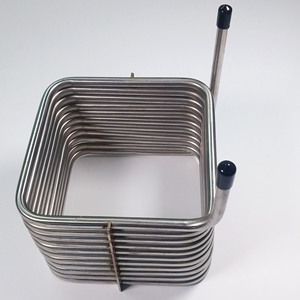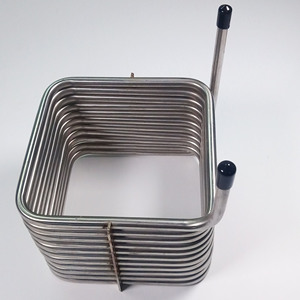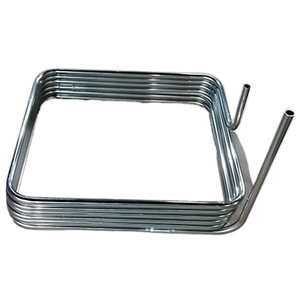
All categories
Featured selections
Trade Assurance
Buyer Central
Help Center
Get the app
Become a supplier

(1031 products available)













Tubes are critical components in heat exchangers that facilitate the transfer of heat between two fluids. A bending heat exchanger coil tube can be classified based on various operational parameters and structural designs. These tube types are instrumental in specific applications in industrial settings due to their distinctive characteristics.
These tubes are ideal for spaces where compact designs are needed. Their ability to support tight bends without loss of material integrity is essential in heat exchangers where flow paths are short.
This type consists of two pipes, one for each fluid. It is the simplest design and very easy to maintain. It handles low to moderate heat transfer needs effectively.
This exchanger features a coiled tube design, often made of stainless steel. The coil allows for compact designs suitable for small spaces. This design is ideal for high-density, low-volume environments.
In this type, one fluid flows through the tubes while another fluid circulates through the shell surrounding the tubes. This design is robust and widely used in heavy-duty applications.
It consists of multiple thin plates, creating a large surface area for heat transfer. It is compact and efficient but typically used in low-viscosity fluid applications.
Bending heat exchanger coil tubes are critical components in industries requiring efficient heat transfer solutions. Their flexibility and durability make them suitable for a range of rigorous applications.
In thermal power plants, bending coil heat exchangers transfer heat from steam to water, increasing energy efficiency. Their ability to withstand high temperatures and pressures makes them ideal for this demanding environment.
These tubes play a pivotal role in cooling, heating, and heat recovery processes in the petrochemical sector. Their resistance to corrosive substances ensures longevity in processing harsh chemicals.
Due to their compactness and efficient cleaning capabilities, these tubes are employed in pasteurization, sterilization, and cooling in the food and beverage industry. They are vital for maintaining the quality and safety of heat-sensitive products.
In the pulp and paper industry, these tubes are used to recover heat from spent cooking liquors. Their ability to handle the extremely hot and corrosive environment is vital for the industry's energy recovery processes.
In the aerospace industry, these tubes are used in aircraft engines and coolers. Their lightweight, high-strength properties, and ability to perform under extreme conditions make them essential for this high-tech industry.
These tubes are commonly found in chillers and cooling towers in HVAC systems, aiding in building temperature regulation. Their flexibility allows for easier installation in complex building structures.
Understanding the key specifications of a bending heat exchanger coil tube helps in selecting the right tube for optimum performance. These tubes are important parts that provide efficient heat transfer in various systems.
Common materials include stainless steel, copper, and carbon steel. Stainless steel is widely used for its resistance to corrosion and high temperatures, making it ideal for demanding environments.
The bend radius indicates the sharpest curve that the tube can make without losing its strength. A smaller radius allows for tighter designs but may increase stress on the material.
Coil tubes typically range from 0.5mm to 2.5mm in wall thickness. A thicker wall enhances durability and pressure resistance but may reduce flexibility.
Coil tube diameters usually range from 10mm to 25mm. A larger diameter provides more surface area for heat exchange. Coil lengths can be customized based on specific operational requirements.
They are often rated to withstand temperatures exceeding 500°C. They also handle high-pressure scenarios, frequently exceeding 30 bar, depending on the application.
The area can vary based on design requirements but is usually between 5 m² and 50 m². A larger area increases efficiency by providing more surface for heat transfer.
Other important features that should be considered are flexibility, corrosion resistance, and pressure differentials.
Choosing the right heat exchanger coil tube involves multiple important factors that directly impact the system's efficiency and reliability. Understanding these factors helps make an informed decision.
Stainless steel, copper, and carbon steel are common materials. Stainless steel is favored for its corrosion resistance and durability in high-temperature environments. Copper, while more conductive, is less durable unless protected from oxidation. Carbon steel, typically coated for corrosion resistance, is cost-effective for high-pressure applications. The material choice should align with the specific fluid types and environmental conditions in the industry.
The bend radius is another key factor, especially in space-constrained setups. A tighter bend radius allows more compact coil designs but may stress the material if not properly engineered. Ensure the chosen tube can accommodate the necessary bends without compromising structural integrity.
Tube wall thickness significantly impacts durability and efficiency. Thicker walls offer greater strength and are more resistant to pressure differentials, making them suitable for high-pressure environments. However, thicker materials might reduce the surface area available for heat transfer.
The design of the coil, including its length and diameter, should be chosen based on the required heat exchange capacity. Larger coils with greater surface areas provide enhanced heat exchange but occupy more space. Conversely, smaller coils fit into tighter spaces but may not offer adequate heat exchange in high-demand scenarios.
In industrial applications, custom coils tailored to specific operational requirements can significantly improve performance. Additionally, consider maintainability; designs that allow easy access for cleaning and repairs can reduce downtime.
A1: It is used to transfer heat from one fluid to another in various industrial applications. Its flexible design allows for compact and efficient heat exchange systems.
A2: Coil tubes in heat exchangers are frequently made from stainless steel, copper, and carbon steel. Each material has unique properties, offering advantages such as corrosion resistance, thermal conductivity, and durability under high pressure.
A3: Tube thickness is crucial as it affects the tube's ability to withstand high pressure, temperature, and corrosive environments. Thicker walls enhance structural integrity, but thinner tubes improve heat transfer efficiency.
A4: The coil design directly affects the surface area available for heat transfer and the fluid flow path. This impacts the overall efficiency of the heat exchanger, determining how effectively it can transfer heat between fluids.
A5: Industries like power generation, petrochemicals, food and beverages, pulp and paper, and HVAC systems benefit greatly. These tubes are essential for efficient heat transfer in energy, chemical processing, and building maintenance.